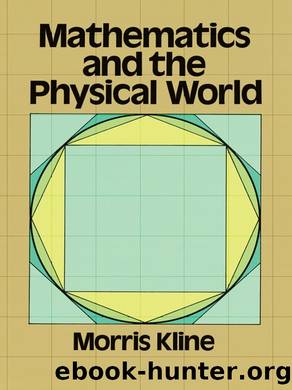Mathematics and the Physical World by Morris Kline

Author:Morris Kline
Language: eng
Format: epub
ISBN: 9780486136318
Publisher: Dover Publications
Published: 2012-10-07T16:00:00+00:00
17: MORE LIGHT ON LIGHT
My design in this Book is not to explain the Properties of Light by Hypotheses, but to propose and prove them by Reason and Experiments: In order to which I shall premise the following Definitions and Axioms.
âNEWTON, IN HIS Opticks
MORE pervasive than motion is the phenomenon of light that permits man to see motions on the earth and in the heavens. Since ancient times scientists have undertaken to investigate the nature of light, its behavior as it passes through a medium such as air or water, and the associated process of vision. The progress they have made is peculiar. As to the physical nature of light we know no more today than men did several thousands of years ago. Yet manâs knowledge of the behavior of light and his power to put the various phenomena of light to use has grown enormously, especially in the last few centuries.
The progress that has been made already in the field of light is similar to the developments in gravitation. Though, as we have noted in the preceding chapter, the nature of the force of gravitation is also a mystery, our mathematical knowledge of this phenomenon is sufficiently powerful to enable man to predict the paths of moving objects on the earth and in the heavens with remarkable preciseness. Some observations of the behavior of the gravitational force led, as we saw, to mathematical laws, and from these, most important new knowledge was derived by purely mathematical processes. The same procedure has been pursued in the investigation of light, and our present concern will be to see how some extremely simple mathematics permits us to acquire mastery of this phenomenon despite our woefully inadequate physical understanding.
Theories as to the nature of light and vision were formulated by many Greeks, among them Plato and Aristotle. A modicum of mathematical knowledge about the behavior of light also dates back to Greek times. Euclid, we saw, knew the law of reflection, namely, that light is reflected from a smooth surface in accordance with the law that the angle of incidence equals the angle of reflection. The Alexandrian Greek, Heron, observed the fact we used in an earlier chapter, that when light travels from one point to another by way of reflection from a mirror, it takes the shortest path. These two mathematical facts were about the only two precise ones the ancient world knew about light.
Though some interest in the phenomenon of light was shown by the Arabians and by the Europeans of the late medieval period and the Renaissance, it was not till the seventeenth century that the subject of light became a major scientific pursuit. The reason for thisâthe invention of the telescope and microscopeâhas already been mentioned.
The telescope itself, according to somewhat debatable history, was invented by several Dutchmen, Hans Lippershey and Zacharias Jansen, spectacle makers, and independently by James Metius, brother of the minor mathematician Adrian Metius. Like many fundamental inventions this one was the result of an accident
Download
This site does not store any files on its server. We only index and link to content provided by other sites. Please contact the content providers to delete copyright contents if any and email us, we'll remove relevant links or contents immediately.
| Applied | Geometry & Topology |
| History | Infinity |
| Mathematical Analysis | Matrices |
| Number Systems | Popular & Elementary |
| Pure Mathematics | Reference |
| Research | Study & Teaching |
| Transformations | Trigonometry |
Modelling of Convective Heat and Mass Transfer in Rotating Flows by Igor V. Shevchuk(6406)
Weapons of Math Destruction by Cathy O'Neil(6206)
Factfulness: Ten Reasons We're Wrong About the World – and Why Things Are Better Than You Think by Hans Rosling(4710)
A Mind For Numbers: How to Excel at Math and Science (Even If You Flunked Algebra) by Barbara Oakley(3250)
Descartes' Error by Antonio Damasio(3247)
Factfulness_Ten Reasons We're Wrong About the World_and Why Things Are Better Than You Think by Hans Rosling(3216)
TCP IP by Todd Lammle(3154)
Fooled by Randomness: The Hidden Role of Chance in Life and in the Markets by Nassim Nicholas Taleb(3079)
Applied Predictive Modeling by Max Kuhn & Kjell Johnson(3038)
The Tyranny of Metrics by Jerry Z. Muller(3025)
The Book of Numbers by Peter Bentley(2928)
The Great Unknown by Marcus du Sautoy(2661)
Once Upon an Algorithm by Martin Erwig(2619)
Easy Algebra Step-by-Step by Sandra Luna McCune(2603)
Lady Luck by Kristen Ashley(2552)
Police Exams Prep 2018-2019 by Kaplan Test Prep(2514)
Practical Guide To Principal Component Methods in R (Multivariate Analysis Book 2) by Alboukadel Kassambara(2512)
All Things Reconsidered by Bill Thompson III(2369)
Linear Time-Invariant Systems, Behaviors and Modules by Ulrich Oberst & Martin Scheicher & Ingrid Scheicher(2346)
